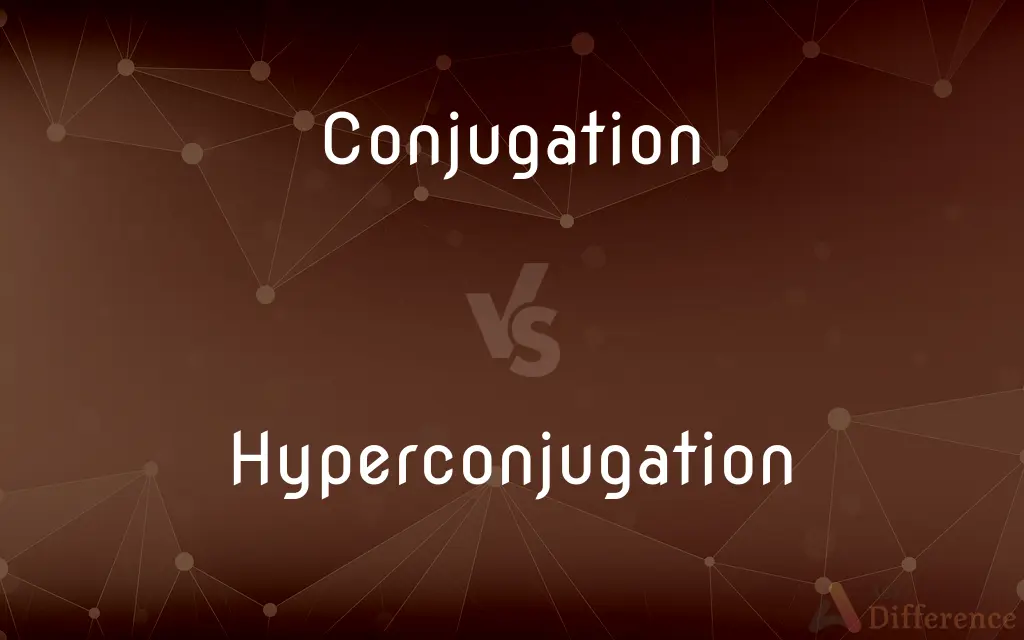Conjugation vs. Hyperconjugation — What's the Difference?
By Maham Liaqat & Urooj Arif — Updated on March 16, 2024
Conjugation involves the delocalization of π electrons across adjacent p-orbitals, enhancing stability, while hyperconjugation involves σ bonds donating electron density to adjacent π systems or vacant orbitals.

Difference Between Conjugation and Hyperconjugation
Table of Contents
ADVERTISEMENT
Key Differences
Conjugation occurs when π electrons are delocalized over several adjacent atoms, usually involving alternating single and double bonds, which stabilizes the molecule. Hyperconjugation, on the other hand, is a more subtle effect where σ electrons in a C-H or C-C bond interact with adjacent π systems or vacant orbitals, also contributing to stabilization but in a different manner.
In conjugated systems, the overlap of p-orbitals along a chain of atoms allows electrons to move more freely, lowering the overall energy of the molecule. In contrast, hyperconjugation involves the interaction of σ bond electrons with an adjacent unfilled or partially filled p-orbital, which can spread and stabilize charge over a larger area but through a less extensive overlap.
Conjugation often results in the absorption of light at longer wavelengths due to the lower energy difference between the highest occupied molecular orbital (HOMO) and the lowest unoccupied molecular orbital (LUMO). Whereas, hyperconjugation typically has a lesser effect on the electronic absorption spectrum, as it involves weaker interactions.
Conjugated molecules are often found in organic dyes and pigments, where the extended delocalization of electrons is responsible for their vivid colors. Hyperconjugation, while it may not lead to such dramatic color changes, plays a crucial role in the stability of carbocations, alkenes, and radicals.
Both conjugation and hyperconjugation influence the reactivity and stability of organic molecules, but they operate through different mechanisms and have varying degrees of impact depending on the molecular context. Conjugation tends to have a more pronounced effect on the molecule's physical properties and reactivity, while hyperconjugation often plays a supporting role in stabilizing certain molecular structures.
ADVERTISEMENT
Comparison Chart
Electron Involvement
Involves π electrons
Involves σ electrons
Orbital Interaction
P-orbital overlap
σ bond to adjacent π or vacant orbital interaction
Impact on Stability
Significantly stabilizes molecules through electron delocalization
Stabilizes molecules, often subtly, through electron donation
Typical Manifestations
Found in alternating single and double bonded systems
Common in molecules with σ bonds adjacent to π systems or vacant orbitals
Effect on Absorption
Causes absorption at longer wavelengths due to lower HOMO-LUMO energy gap
Lesser impact on absorption spectrum
Compare with Definitions
Conjugation
Conjugation refers to the delocalization of π electrons across p-orbitals in adjacent atoms, enhancing stability.
The conjugation in benzene contributes to its exceptional stability.
Hyperconjugation
Hyperconjugation plays a role in the reactivity of organic molecules, particularly in radical species.
The stability of alkyl radicals is enhanced by hyperconjugation.
Conjugation
Conjugated molecules often exhibit unique electronic properties, useful in organic electronics.
Conjugated polymers are employed in organic light-emitting diodes (OLEDs).
Hyperconjugation
This effect can influence the molecular structure and bond lengths subtly.
Hyperconjugation is responsible for the slight elongation of C-H bonds in alkyl groups.
Conjugation
It occurs in systems with alternating single and double bonds, allowing for extended electron mobility.
The conjugated system in 1,3-butadiene absorbs ultraviolet light.
Hyperconjugation
It contributes to the stabilization of molecules without the necessity of alternating bonds.
Hyperconjugation in alkenes increases their stability compared to non-hyperconjugated counterparts.
Conjugation
Conjugation lowers the energy difference between molecular orbitals, leading to distinct coloration in some compounds.
The bright color of beta-carotene is due to its long conjugated system.
Hyperconjugation
Hyperconjugation involves the interaction of σ-bonded electrons with adjacent π systems or empty orbitals.
Hyperconjugation stabilizes carbocations by dispersing positive charge.
Conjugation
This effect is crucial in the stability and reactivity of aromatic compounds.
Conjugation in aromatic rings contributes to their resistance to addition reactions.
Hyperconjugation
Despite being less pronounced than conjugation, hyperconjugation is significant in organic chemistry.
Hyperconjugation effects are critical in explaining the order of alkene stability.
Conjugation
The act of conjugating.
Hyperconjugation
In organic chemistry, hyperconjugation (or σ-conjugation) refers to the delocalization of electrons with the participation of bonds of primarily σ-character. Usually, hyperconjugation involves the interaction of the electrons in a sigma (σ) orbital (e.g.
Conjugation
The state of being conjugated.
Hyperconjugation
(organic chemistry) A weak form of conjugation in which single bonds interact with a conjugated system
Conjugation
The inflection of a particular verb.
Conjugation
A presentation of the complete set of inflected forms of a verb.
Conjugation
A class of verbs having similar inflected forms.
Conjugation
The temporary union of two bacterial cells during which one cell transfers part or all of its genome to the other.
Conjugation
The coming together of things; union.
Conjugation
(grammar) In some languages, one of several classifications of verbs according to what inflections they take.
Conjugation
(grammar) The act or process of conjugating a verb.
Conjugation
(grammar) The product of that act: the conjugated forms of a verb, collected into a list or recitation.
Principal parts
Conjugation
(chemistry) A system of delocalized orbitals consisting of alternating single bonds and double bonds
Conjugation
(mathematics) A mapping sending x to gxg-1, where g and x are elements of a group; inner automorphism
Conjugation
(mathematics) A function which negates the non-real part of a complex or hypercomplex number; complex conjugation
Conjugation
The act of uniting or combining; union; assemblage.
Mixtures and conjugations of atoms.
Conjugation
Two things conjoined; a pair; a couple.
The sixth conjugations or pair of nerves.
Conjugation
The act of conjugating a verb or giving in order its various parts and inflections.
Conjugation
The state of being joined together
Conjugation
The inflection of verbs
Conjugation
The complete set of inflected forms of a verb
Conjugation
A class of verbs having the same inflectional forms
Conjugation
The act of pairing a male and female for reproductive purposes;
The casual couplings of adolescents
The mating of some species occurs only in the spring
Conjugation
The act of making or becoming a single unit;
The union of opposing factions
He looked forward to the unification of his family for the holidays
Common Curiosities
How does hyperconjugation stabilize molecules?
Hyperconjugation stabilizes molecules by allowing σ electrons in a C-H or C-C bond to donate electron density to adjacent π systems or vacant orbitals, spreading charge and stabilizing the molecule.
What is conjugation in chemistry?
Conjugation involves the delocalization of π electrons across adjacent p-orbitals in a molecule, leading to enhanced stability and unique properties.
Can conjugation affect a molecule's color?
Yes, conjugation can lower the energy gap between molecular orbitals, leading to absorption of light at longer wavelengths and sometimes causing vivid colors.
How do conjugation and hyperconjugation differ in their effects on molecular stability?
Conjugation generally has a more pronounced effect on molecular stability through extensive delocalization of π electrons, while hyperconjugation provides stability more subtly through σ to π or vacant orbital interactions.
How does hyperconjugation affect bond lengths?
Hyperconjugation can lead to a slight elongation of C-H bonds in alkyl groups due to the donation of electron density to adjacent structures.
Are there any limitations to the stabilizing effects of conjugation and hyperconjugation?
The stabilizing effects of both conjugation and hyperconjugation are dependent on the molecular context, including the presence of other functional groups and the overall molecular structure.
Can conjugation and hyperconjugation coexist in a single molecule?
Yes, a molecule can exhibit both conjugation and hyperconjugation, each contributing to the molecule's stability and reactivity in different ways.
Why are conjugated systems found in dyes and pigments?
Conjugated systems are common in dyes and pigments due to their ability to absorb light at specific wavelengths, leading to the vivid colors associated with these substances.
How do conjugation and hyperconjugation influence reactivity?
Conjugation often makes molecules more reactive towards certain types of reactions, like electrophilic aromatic substitution, while hyperconjugation can stabilize reactive intermediates, influencing reaction pathways.
What role does hyperconjugation play in the stability of alkenes?
Hyperconjugation helps to stabilize alkenes by dispersing the electron density of σ bonds across adjacent π systems, making them less reactive.
How does the strength of hyperconjugation compare to that of conjugation?
Generally, conjugation is considered to have a stronger effect on molecular stability and properties than hyperconjugation, due to the more extensive delocalization of electrons.
Is hyperconjugation only important in carbocations?
While hyperconjugation is particularly important in stabilizing carbocations, it also plays a role in the stability of alkenes, radicals, and other molecular structures.
Can the presence of conjugation in a molecule be easily identified?
Conjugation is often identifiable by the presence of alternating single and double bonds in a molecule, although spectroscopic techniques can provide more definitive evidence.
How does the electronic absorption spectrum differ between conjugated and hyperconjugated molecules?
Conjugated molecules typically show absorption at longer wavelengths due to the reduced energy gap between their HOMO and LUMO, whereas hyperconjugated molecules might not show such dramatic changes in their absorption spectrum.
Are there specific conditions that enhance hyperconjugation effects?
Hyperconjugation effects can be enhanced by the presence of multiple alkyl groups adjacent to a π system or vacant orbital, increasing the donation of electron density.
Share Your Discovery

Previous Comparison
Promotion vs. Discount
Next Comparison
Vine vs. WineAuthor Spotlight
Written by
Maham LiaqatCo-written by
Urooj ArifUrooj is a skilled content writer at Ask Difference, known for her exceptional ability to simplify complex topics into engaging and informative content. With a passion for research and a flair for clear, concise writing, she consistently delivers articles that resonate with our diverse audience.













































